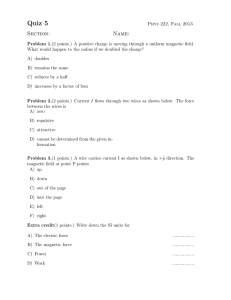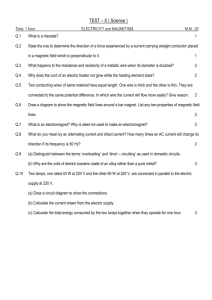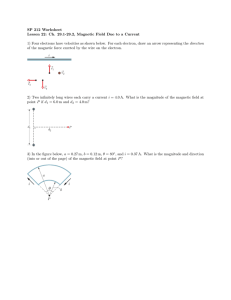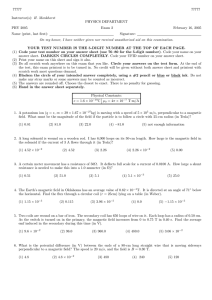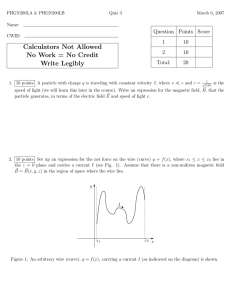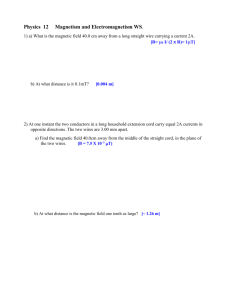Name _________________ Solutions to Test 2 March 5, 2014
advertisement
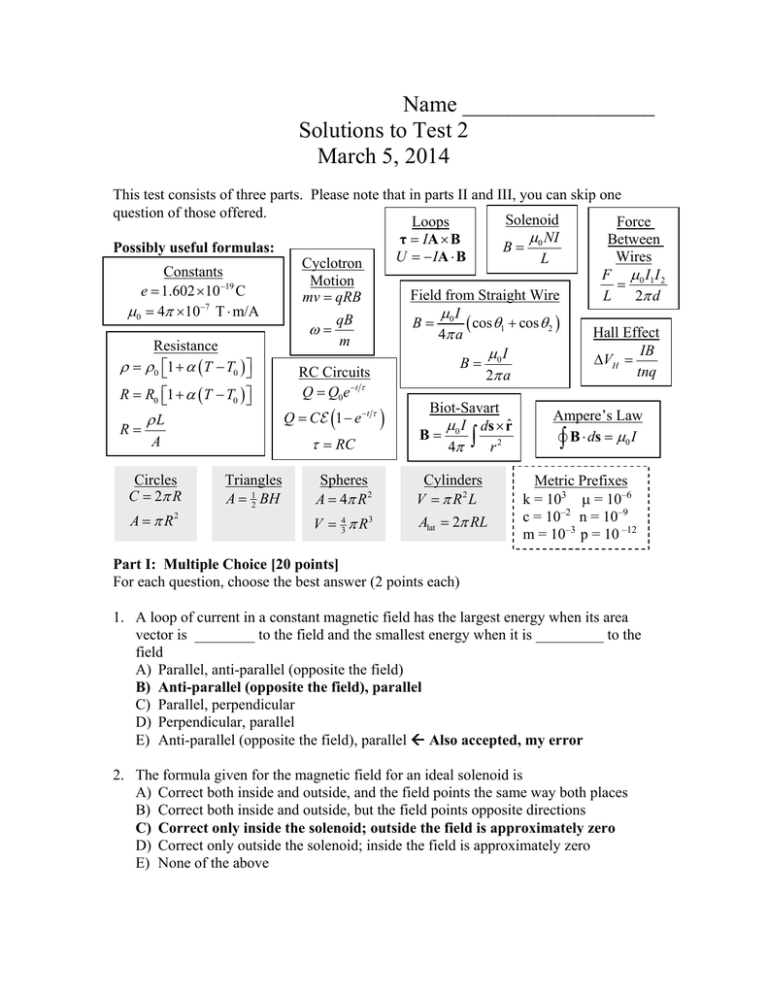
Name _________________ Solutions to Test 2 March 5, 2014 This test consists of three parts. Please note that in parts II and III, you can skip one question of those offered. Solenoid Loops Force 0 NI τ IA B Between B Possibly useful formulas: U IA B Wires L Cyclotron Constants 0 I1 I 2 F Motion 19 e 1.602 10 C Field from Straight Wire L 2 d mv qRB 7 0 4 10 T m/A I qB B 0 cos 1 cos 2 Hall Effect 4 a m Resistance IB 0 I V B H 0 1 T T0 tnq RC Circuits 2 a t Q Q0 e R R0 1 T T0 Biot-Savart Ampere’s Law Q C 1 e t L 0 I ds rˆ R B A B ds 0 I RC 4 r 2 Circles C 2 R A R2 Triangles A 12 BH Spheres A 4 R 2 V 43 R 3 Cylinders V R2 L Alat 2 RL Metric Prefixes k = 103 = 10–6 c = 10–2 n = 10–9 m = 10–3 p = 10 –12 Part I: Multiple Choice [20 points] For each question, choose the best answer (2 points each) 1. A loop of current in a constant magnetic field has the largest energy when its area vector is ________ to the field and the smallest energy when it is _________ to the field A) Parallel, anti-parallel (opposite the field) B) Anti-parallel (opposite the field), parallel C) Parallel, perpendicular D) Perpendicular, parallel E) Anti-parallel (opposite the field), parallel Also accepted, my error 2. The formula given for the magnetic field for an ideal solenoid is A) Correct both inside and outside, and the field points the same way both places B) Correct both inside and outside, but the field points opposite directions C) Correct only inside the solenoid; outside the field is approximately zero D) Correct only outside the solenoid; inside the field is approximately zero E) None of the above 3. Which of the following explains how a motor works? A) Electric fields cause forces on stationary charges in the wires B) Electric fields cause forces on currents in the wires C) Magnetic fields cause forces on stationary charges in the wires D) Magnetic fields cause forces on currents in the wires E) Magic fairies named Maxwell, Ampere, Biot, and Savart push them around 4. If two current-carrying wires are parallel and near each other, will there be a force between them? A) Yes: attractive if the currents run opposite, repulsive if the currents run the same way B) Yes: attractive if the currents run the same way, repulsive if the currents run opposite C) Yes: always attractive D) Yes: always repulsive E) No 5. In a velocity selector, there are charged particles in a region of a magnetic field. How come the particles move in a straight line, despite the magnetic field? A) The particles are moving parallel to the magnetic field, so no force B) The particles are moving anti-parallel to the magnetic field, so no force C) The particles move so slowly that the magnetic force is negligible D) The particles attract electrons that cancel the charge, so no force E) There is an electric field that exactly balances the magnetic field R1 6. For the two resistors at right, what is the formula for the total resistance? 1 1 1 1 1 1 A) R R1 R2 B) R1 R2 C) R D) E) R R1 R2 R1 R2 R R1 R2 R 7. If a light bulb is consuming 60 W of power from a 120 V source, what is the current in the light bulb? A) 7200 A B) 2A C) ½ A D) 1/30 A E) 1/7200 A R2 8. In the formula F IL B for the force on a wire in a magnetic field, what direction is the vector L supposed to point? A) Along the wire in the direction the current is flowing B) In the direction of the magnetic field C) Opposite the direction of the magnetic field (anti-parallel) D) Perpendicular to both the wire and the magnetic field E) Circling the wire in a manner corresponding to the right-hand rule 9. What happens to a charged particle in a uniform magnetic field, if it is initially moving perpendicular to the magnetic field? A) It oscillates back and forth like a simple harmonic oscillator B) It moves in a circle perpendicular to the magnetic field B) It moves in a straight line at constant speed C) It moves in a straight line but at constant acceleration D) It switches its direction to move along the magnetic field E) It gradually slows down and stops 10. Suppose the magnetic field is integrated over the surface of a sphere, and the result is positive, B ndA 0 . What does this tell us about what is going on inside the sphere? A) There is net positive charge inside the sphere B) There must be the north end of a magnet or solenoid inside C) There must be the south end of a magnet or solenoid inside D) There is a net current flowing into the region E) This should be impossible; this integral must always be zero Part II: Short answer [20 points] Choose two of the following questions and give a short answer (1-3 sentences) or brief sketch (10 points each). 11. In the circuit sketched at right, there is initially no charge on the capacitor. Explain qualitatively what happens when you close the circuit, giving any relevant equations. – + R C As you close the switch, current begins to flow, charging up the capacitor. It continues flowing until it asymptotically approaches, Q C . At any given time t, the charge will be Q C 1 et , where the time constant is RC . 12. Explain qualitatively what the Hall effect is. You do not need any equations, though a sketch might help. When a current flows through a wire in the presence of a magnetic field, the charges accumulate on one side, producing an electric field that causes a voltage difference between the two sides. The voltage difference is perpendicular to both the direction of the current and the direction of the magnetic field. 13. Explain how an ideal battery differs from a realistic battery. A circuit picture explaining this might help. – + r An ideal battery produces the same voltage no matter what current demand is made on it. A realistic battery has internal resistance, and is essentially a battery with a resistor of resistance r (the internal resistance) in parallel with it. The battery will produce fairly consistent voltage for low current demands, but when the current demands get too much, the effective voltage out of the resistor will drop. 14. Consider the circuit at right. Assume for the moment that the currents are as marked; that is to say, the top two branches have current to the right, and the bottom one to the left. (a) Use Kirchoff’s first law to get one or more simple relationships between the three currents. – + I1 6V 12 V – + 3 Part III: Calculation: [60 points] ` Choose three of the following four questions and perform the indicated calculations (20 points each) I2 I3 8 Using the vertex at the right, the first two currents are going in, and the third one is coming out, so I1 I 2 I 3 (b) Use Kirchoff’s second law to get one or more additional relationships between all three currents. Going clockwise around the top circuit, starting at the upper left, we first go from negative to positive (up) by 6 V, then we go downstream through the resistor with current I1, and then we go from positive to negative (down) by 12 V, so we have 6 3I1 12 0, or 3I1 6 . Going clockwise around the bottom circuit, starting at the upper left, we first go from negative to positive (up) by 12 V, then we do downstream through the resistor with current I3. So we have 12 8 I 3 0, or 8 I 3 12 . (c) Find all three currents I1, I2, and I3. Which direction (right or left) are the three currents actually moving? The two equations found in part (b) are pretty trivial to solve. We can then use the equation from part (a) to find the remaining current. So we have I1 6 3 2.0 A , I 3 12 8 1.5 A , I 2 I 3 I1 1.5 A 2.0 A 3.5 A . We see that I1 came out negative, which just means we guessed wrong on the direction. In fact, I2 is to the right and both I1 and I3 are to the left. 15. Two resistors are powered by a 180. V power source as shown at right, and the current is measured by the ammeter A. Resistor R1 is made of carbon, and at T0 20C , has resistance R1 20.0 k and has temperature coefficient of resistivity 180 V – + A 1 5.0 10 / C . Resistor R2 has unknown resistance and is 4 R1 R2 made of an unknown substance. (a) At T0 20C , the ammeter reads I 4.00 mA . What is the resistance of the second resistor R2 at this temperature? The total voltage is V IR . We therefore have the total resistance as R V 180. V 45, 000 45.0 k . 0.004 A I Since the resistors are in series, the total resistance is R R1 R2 . We therefore have R2 R R1 45.0 k 20.0 k 25.0 k . (b)The entire structure is now immersed in boiling water at temperature T 100C . It is discovered that the ammeter still reads I 4.00 mA . What is the temperature coefficient of resistivity 2 for the second resistor? Because the current is unchanged, the total resistance must be unchanged. The carbon resistor now has its resistance change to R1 20.0 k 1 T T0 20.0 k 1 5.0 104 / C 100C 20C 20.0 k 1 .04 19.2 k . The balance must be taken up by the other resistor, so now R2 R R1 45.0 k 19.2 k 25.8 k . This must be the modified resistance due to temperature, so we must have 25.8 k 25.0 k 1 T T0 25.0 k 1 100C 20C 25.0 k 1 80C , 1.032 1 80C , 0.032 80C , 0.032 4.0 104 / C. 80C 16. A loop of wire is in the shape of an equilateral triangle of side 6.00 cm, with a current of 3.00 A traveling clockwise around the wire. We are interested in the magnetic field at the exact center of the triangle. (a) What is the angle in the diagram at right? What is the distance d from one of the sides of the triangle to the center? d The triangle is equilateral, which means the three 6.00 cm angles are equal. Since they add up to 180, each one must be 60. The angle is half this angle, so = 30. The base of the triangle is 6.00 cm, and the small triangle drawn in has horizontal leg half of this, or 3.00 cm. The far side can then be calculated using the tangent, so that tan 30 d 3.00 , so d 3.00 cm tan 30 cm 3 cm 1.732 cm . 3.00 cm 3 (b) What is the magnetic field (magnitude and direction) at the center of the triangle due to the loop? We need to use the formula for the magnetic field from a straight line segment. We need the two base angles, one of which is = 30, and the other one (not shown) will be exactly the same. We therefore have 4 107 T m/A 3.00 A 0 I B cos 1 cos 2 cos 30 cos 30 30.0 T . 4 a 4 3 102 m This is the field from just one side. Its direction can be determined from pointing your thumb in the direction of the wire, then the magnetic field will, at the center, point down into the loop. The magnetic fields from the other two sides are exactly the same, so in total, Btot 90.0 T , into the page. (c) A positron (mass m 9.109 1031 kg , charge e 1.602 1019 C ) is at the center of this triangle, moving to the right at v 1.27 107 m/s . Find the acceleration (direction and magnitude) of this positron. The charge is positive. Since the velocity is to the right, and the magnetic field is down, the right hand rule tells you that v B will be towards the top of the page. The charge is positive, so it will not reverse it, and this is the direction of the force. Because the velocity and magnetic field are perpendicular, we don’t have to include any fancy angles, so we have 1.602 1019 C 1.27 107 m/s 9.00 105 T F qv B a , a 2.011014 m/s 2 . 31 m m 9.109 10 kg 17. A coaxial cable has a thin center wire surrounded by a thin cylindrical layer with radius r = 3.00 mm. The central wire (small dot) has a current of I1 = 1.20 A coming out of the paper towards us, and the cylindrical layer (solid circle) has an unknown current I2 in it. (a) Find the magnetic field at a distance r = 2.00 mm from the central wire. Find its magnitude, and describe or sketch its direction. I2 I1 out 5 mm 3 mm The magnetic field will make a circle around the wire at 2.00 mm. Using the right hand rule, if you point your thumb out of the screen, the magnetic field will wrap counter-clockwise around the wire. We can use Ampere’s law to figure out how large it is, but it is easier to take advantage of the formula for the magnetic field from an infinite wire. We ignore the cylinder, because it is outside the radius where we are working. We therefore have I 4 10 T m/A 1.20 A 1.20 104 T 120. T . B 0 3 2 a 2 2.00 10 m 7 As already stated, it is going counterclockwise around the wire, as sketched in above. (b) At a distance of r = 5.00 mm, the magnetic field is found to have a magnitude of 12.00 T, oriented in a clockwise direction around the cable, as shown by the dashed curves. What is the current I2, and is it into or out of the paper? We can use the same formula, but this time the current will include both currents, and the direction of the currents must be reversed. We have B I 0 I , 2 a 2 aB 0 2 5.00 103 m 12.00 106 T 4 107 T m/A 0.300 A . This is the total current going into the plane, because the field is going the opposite direction. But the 1.20 A from the previous part is coming out of the plane, so it counts as negative. Since the total is 0.300 A, there must be 1.50 A going into the plane to cancel out the current coming out from the central wire and leave 0.300 A left over. 1.50 A into the plane 12 T
